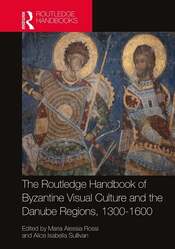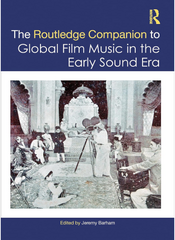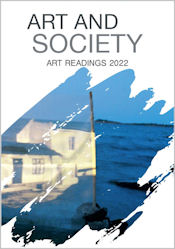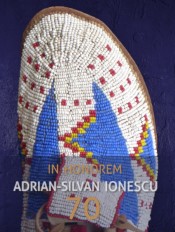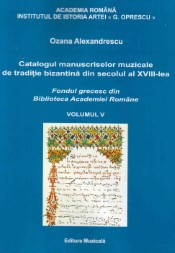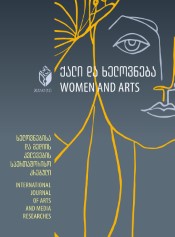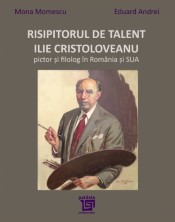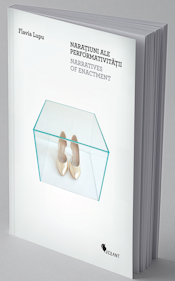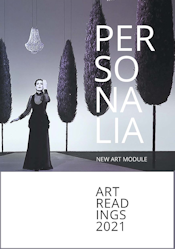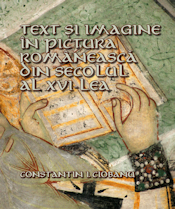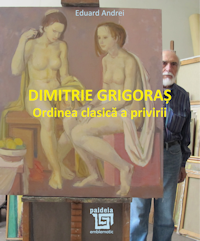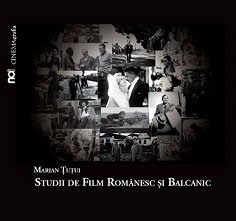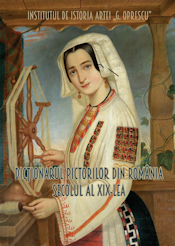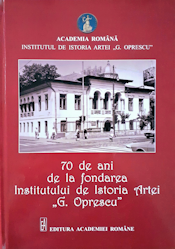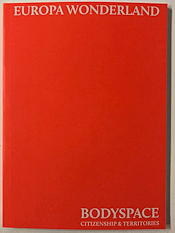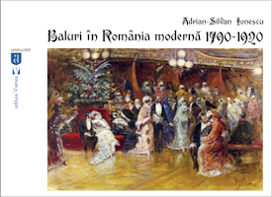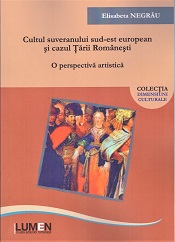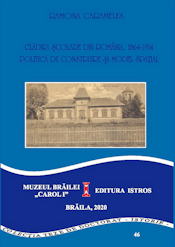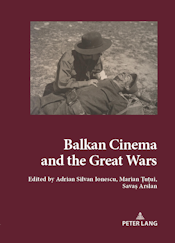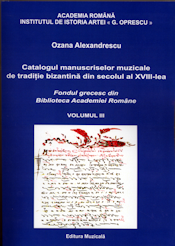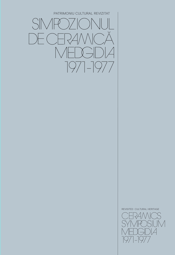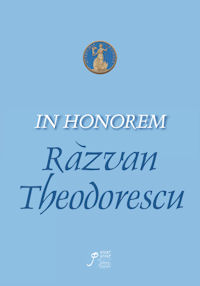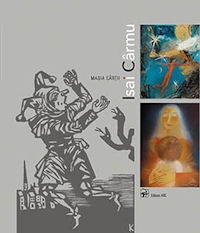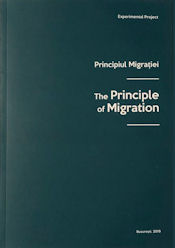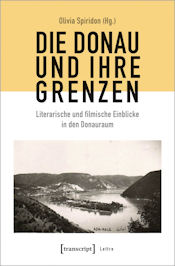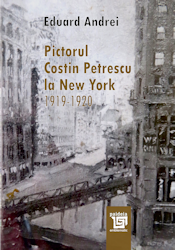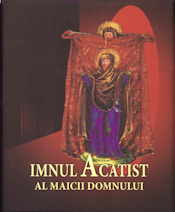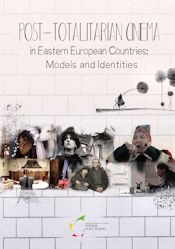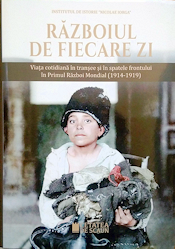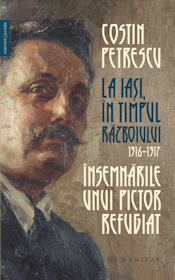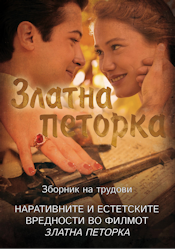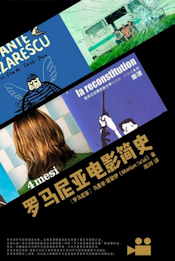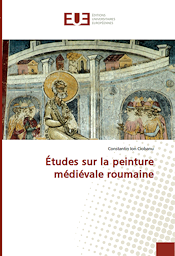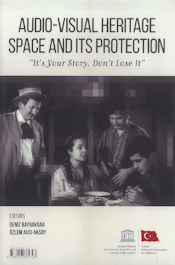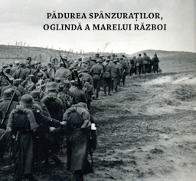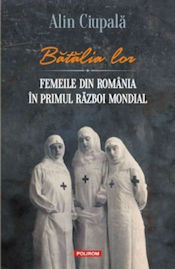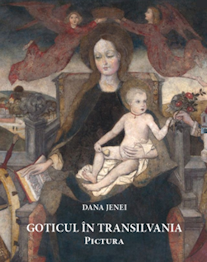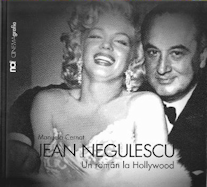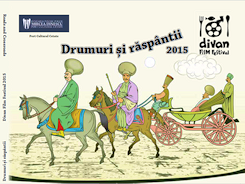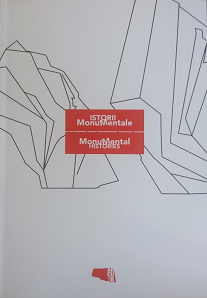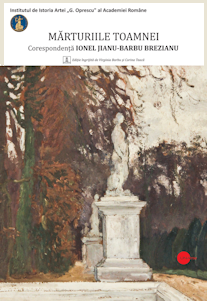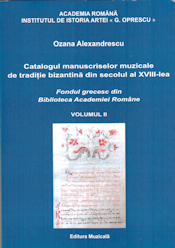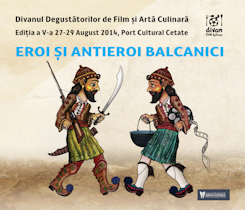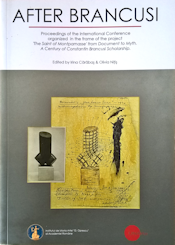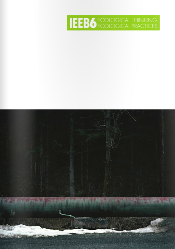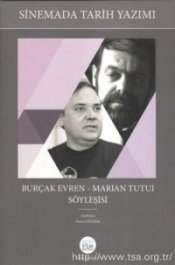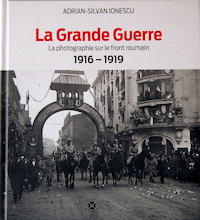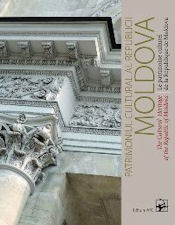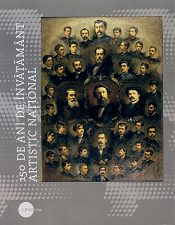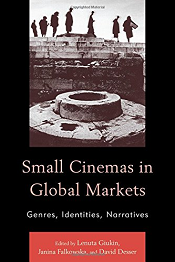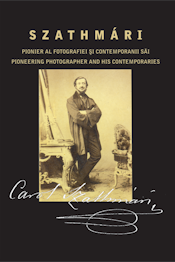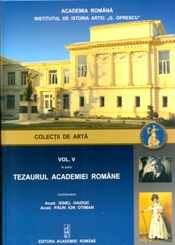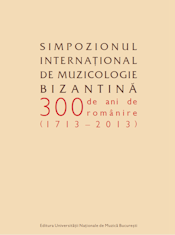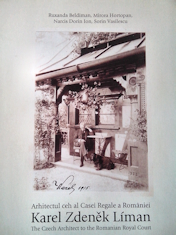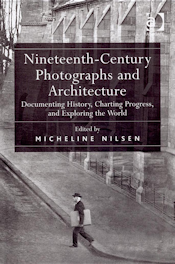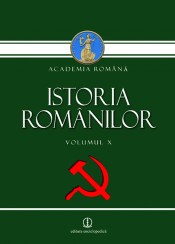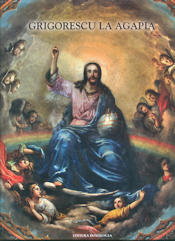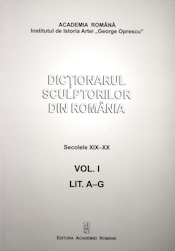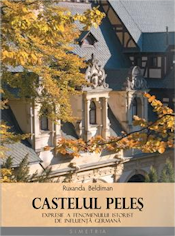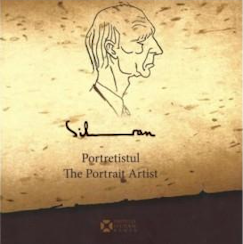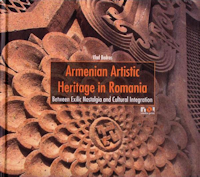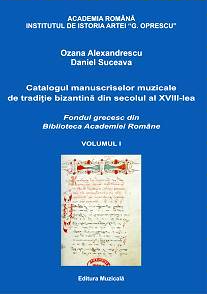home | past events | books 2010-2024 | wednesday meetings | IAH kinema | contact |
Books by researchers of G. Oprescu Institute of Art History
2010-2025*
*For a more comprehensive list of the books published by our researchers, please visit the pages Joint volumes and Books on the website of G. Oprescu Institute of Art History.
OZANA ALEXANDRESCU
Catalogul manuscriselor muzicale de tradiţie bizantină din secolul al XIX-lea. Fondul grecesc din Biblioteca Academiei Române, Vol. I, Bucureşti: Editura Muzicală, 2025, 255 p.
Language(s): Romanian
ISBN (gen.): 978-973-42-1426-6
ISBN (vol. I): 978-973-42-1424-2
The work continues the approach from Catalogul manuscriselor muzicale de tradiţie bizantină din secolul al XVIII-lea. Fondul grecesc din Biblioteca Academiei Române, in five volumes: I (2010, signed by Ozana Alexandrescu and the late Daniel Suceava), II (2015), III (2020), IV (2021), and V (2022).
Icons In-Between: Eastern Christian Art from Border Regions. Belarus, Ukraine, Romania, Western Balkans, Greece, exhibition catalogue, ed.: Liliya Berezhnaya, Recklinghausen Icon Museum, 2025, 134 p.
ISBN: 978-3-910440-05-0
Language(s): English
The exhibition Icons in-Between at the Icon Museum in Recklinghausen (Germany), running from 26 January to 6 July 2025, showcases the cultural exchanges between East and West reflected in icon painting, spanning from Crete to Kyiv. A key focus is the veneration of miraculous icons of the Mother of God shared by both Orthodox and Catholic communities. In addition, the exhibition explores the rare visual encounters with Islam as depicted in icons.
Elisabeta Negrău, researcher at the Institute of Art History, contributed several texts to the exhibition catalogue. The event was curated by Dr. Liliya Berezhnaya, a member of the ERC project ORTHPOL (“Orthodoxies and Politics: The Religious Reforms of the Mid-17th Century in Eastern and Southeastern Europe”) held at the Austrian Academy of Sciences in Vienna.
The open source catalogue can be downloaded from: https://works.hcommons.org/records/8gpf9-fxb87.
Geopolitics to Geocriticism: A Study of TV Series in Türkiye, Serbia, Romania and Beyond, editor: Deniz Bayrakdar, Cambridge Scholars Publishing, 2024, 369 p.
ISBN: 9781036413972
Language(s): English
The volume includes 11 studies and two interviews, signed by 13 academics from Turkey, Great Britain, Serbia, and Romania, about TV series seen from an analytical perspective and the perspective of cultural diplomacy through artistic products. Chapter 9, "A Romanian Series (1978) About the Adventures on the Seas of Some Romanians, Turks, and Greeks, Including Pirates and Exploration", was conceived by Dr. Marian Țuțui.
A Spring of Hope A Winter of Despair, author and curator: Olivia Nițiș, publisher: Dana Sarmeş, Timișoara: Editura Contrasens, 2024, 96 p.
ISBN: 9786069534489
Language(s): English
Catalogue of the Romanian-Czech exhibition A Spring of Hope, a Winter of Despair, which was presented at Hala Faber, Timișoara, and itinerated at Pragovka Gallery, Prague. The project includes a selection of works by artists representative of the conceptualism of the 1970s and 1980s, continuing with the transition and contemporary periods.
Klassiker des rumänischen Films, ed. by Dana Duma, Stephan Krause and Anke Pfeifer, Schüren Verlag, Marburg, 2024, 228 p.
ISBN: 9783741003950
Language(s): German
The collective volume comprises in-depth studies of 25 important films created in over a century of Romanian cinema, from Romania’s Independence (1912, directed by Grigore Brezeanu and Aristide Demetriade), to Touch Me Not (2018, directed by Adina Pintilie). Among the 27 Romanian and foreign film scholars who contributed to this landmark work are our colleagues from the Department for Dramatic Art and Cinema: Dr. Marian Țuțui (Head of the Department), who analyzed È pericoloso sporgersi, Nae Caranfil’s debut from 1993, and Phd Candidate Mihai Fulger, who examined California Dreamin’ (Endless), Cristian Nemescu’s only feature film, released in 2007.
Whose Is This Song? Balkan Nationalism, Greece and Shared Culture, edited by Eleni Elefterias-Kostakidis, Hellenic Theorem Publishers, Sydney, 2024, 230 p.
ISBN: 9780646819945
Language(s): English
The volume, edited by Eleni Elefterias-Kostakidis (University of Sydney), is a comparative work dedicated to both national initiatives and transnational phenomena. Our colleague Marian Țuțui authored two chapters: "Four Views of the Balkans from Down Under" and "The Visual Heritage of the Manakia Brothers in the Balkan Countries". The Romanian researcher analysed in his first study seven Australian fiction films in which different representations of the Balkans appear, from a place of refuge to a land of violence that the inhabitants leave in search of peace at the other end of the world; the second study sheds light on the work of Vlach brothers Ienache and Miltiade Manakia, the pioneers of Balkan cinema claimed by six countries in the region.
The Routledge Handbook of Byzantine Visual Culture in the Danube Regions, 1300–1600, edited by Maria Alessia Rossi and Alice Isabella Sullivan, Routledge, 2024, 422 p. and 96 color illustrations
ISBN: 9780367639549
Language(s): English
The volume brings to light the interconnectedness of this broad geographical area too often either studied in parts or neglected altogether, emphasizing its shared history and heritage of the regions of modern Greece, Croatia, Serbia, Bulgaria, Romania, Hungary, Slovakia, and Czechia. The aim is to challenge established perceptions of what constitutes ideological and historical facets of the past, as well as Byzantine and post-Byzantine cultural and artistic production in a region of the world that has yet to establish a firm footing on the map of art history. The 24 chapters offer a fresh and original approach to the history, literature, and art history of the Danube regions, thus being accessible to a wide audience thematically, chronologically, or by case study; each part can be read independently or explored as part of a whole.
Two members of the G. Oprescu Institute of Art History have cotributed with synthesis studies to the volume: Elisabeta Negrău authored the chapter dedicated to The Visual Culture of Wallachia before and after 1453, while Vlad Bedros wrote the chapter on Moldavian Visual Culture before and after 1453.
The Routledge Companion to Global Film Music in the Early Sound Era, edited by Jeremy Barham, Routledge, 2024, 808 p.
ISBN: 978-1138586697
Language(s): English
In a major expansion of the conversation on music and film history, The Routledge Companion to Global Film Music in the Early Sound Era draws together a wide-ranging collection of scholarship on music in global cinema during the transition from silent to sound films (the late 1920s to the 1940s).The volume comprises 50 studies signed by 60 researchers from all over the world.
Chapter 22 –„Who is Singing over there? The Potpourri of Multiple Voices in Early Sound Cinema of the Balkans” – is authored by our colleague Marian Țuțui together with Ana Grgić, associate professor at Babeș-Bolyai University – Cluj-Napoca. Their study is dedicated to the introduction of sound in ex-Yugoslavian, Romanian, Bulgarian and Albanian cinema, as well as to the first musical films made in these countries.
LUCIAN SINIGAGLIA
Universul teatral bucureştean şi politicile culturale după 23 august 1944. Amurgul teatrului burghez. Prin furtunile realismului socialist, with a foreword by Miruna Runcan, Cluj: Presa Universitara Clujeană, 2023, 180 p. + 113 black and white ill.
ISBN: 9786063718489
Language(s): Romanian
This work (...) is the result of many years' effort to bring to light and valorise, from the darkness of the Romanian archives, the documents related to the way in which the Romanian theatrical life evolved in the most disturbed, critical, period of the 20th century: that of the establishment of communism. (...). Lucian Sinigaglia chose as his model the monumental tomes of Ioan Massoff published in the decades 1960-1980, from which he borrows (...) the attention for the descriptive details regarding the theatrical show and its authors. But as every valuable act of emulation is also one of overcoming the master, the author offers us a refined combination of the political analysis of the context, well-grounded and argued, with completely unknown extracts from the chronicles of the time, interspersed with testimonies from the volumes of memoirs or from the biographical ones about the most important artists of the period. The multi-layered research process naturally leads to rearrangements, spectacular reversals of the situation and the dismantling of many mythologies that continue to propagate in the theatrical world even more than seventy years later.
Miruna Runcan
Valentina Rusu Ciobanu. Catalog Raisonné, vol. I-II, edited by Victoria Nagy Vajda, with studies by Constantin I. Ciobanu, Codrina-Laura Ioniță, Rodica Ursachi, Mircea V. Ciobanu, București: Arbor Institute for Culture, 2023, 399 p. + colour ill.
Language(s): Romanian
ISBN vol. I: 978-973-0-38478-9; ISBN vol. II: 978-973-0-38411-6
The catalogue lists all the known works of the painter Valentina Rusu Ciobanu (1920-2021), also including four studies, a chronology, a list of exhibitions, bibliographic references, etc.
Both volumes of the catalogue are available online.
Valentina Rusu Ciobanu was "one of the most important personalities of the Bessarabian fine arts who, together with Mihail Grecu, laid the foundations of the Chisinau’s contemporary school of painting (...) Despite the pressures of a political order that she faced for most of her life, Valentina Rusu Ciobanu managed to keep unaltered her personal dignity and the individuality of her creative discourse..." (Constantin I. Ciobanu)
"I only paint when I feel eternity in front of me." This was the confession of the Bessarabian painter Valentina Rusu Ciobanu, born and raised in the young kingdom of Romania, formed in the atmosphere of Romanian interwar culture, but forced to return to a Bessarabia that had become a Soviet republic." (Codrina-Laura Ionita)
Silvan – un portretist între literații, muzicienii și actorii secolului XX (introduction, chronology and selection of works by Adrian-Silvan Ionescu), Art Museum Craiova, Craiova: Info, 2023
Language(s): Romanian
ISBN: 9786066532020
The volume accompanied the exhibition bearing the same title, hosted by Art Museum Craiova between 2 May and 15 July 2023. The exhibition included 40 graphic works by Silvan Ionescu, donated to the museum by the artist's son, Adrian-Silvan Ionescu. Among the personalities portrayed by the artist in these works are Constantin Brâncuși, Cik Damadian, Ion Țuculescu, Marin Sorescu, George Apostu, Const. D. Fortunescu, Elena Farago, Mihnea Gheorghiu, Gheorghe Dumitrescu-Bistrița, Spiru Vergulescu, V.G. Paleolog, I.D. Sîrbu, Amza Pellea and Nicolae Herlea.
Art and Society. Art readings 2022 (ed. by Katerina Gadjeva), Sofia: Institute of Art Studies – BAS, 2023, 478 p.
Language(s): articles in Bulgarian or English, with abstracts in both languages
ISBN 978-619-7619-22-5
The papers in this volume are international reports submitted to the Institute of Art Studies – Bulgarian Academy of Sciences (BAS) for the 18–20 April 2022 edition of the Art Readings Conference, New Art Module. The papers were peer reviewed and only the ones that successfully went through the selection and editing procedure were published in the present volume. They deal with a wide range of problems, tackling from various perspectives the relations between art and society. The authors are experts in the history of arts, drama and theatre studies, literary and film studies, ethnology and folklore studies, musicology and choreography studies.
The section “Screen arts” includes the study of Marian Țuțui, a researcher from G. Oprescu Institute of Art History, entitled The influence of the Bulgarian National Television on the Romanian public in 1980s.
Soft Power of the Balkan Screens/Meka moć ekrana Balkana (editors: Nevena Daković and Aleksandra Milovanović), Faculty of Dramatic Arts – Institute for theatre, film, radio and television, Belgrade, 2022, 178 p.
Language(s): articles in English, French and Serbian, with abstracts in Serbian or English
ISBN 978-86-82101-99-4 (FDU)
The volume includes the papers presented during the conference under the same name on 26–27 May 2022. The conference was organised by the Faculty of Dramatic Arts and the Institute for Theatre, Film, Radio and Television in Belgrade, in collaboration with the Kadir Has University in Istanbul and the Belgrade University. The volume comprises articles by 15 researchers from Serbia, the USA, Turkey, Bulgaria, Romania, and Slovakia. In the section “Cinema Screens”, our colleague Marian Țuțui published the study Soft Power of Exotic Romania.
In honorem Adrian-Silvan Ionescu 70. Colecție de studii și amintiri despre Adrian-Silvan Ionescu, editors: Marian Țuțui (Institute of Art History) and Aurelian Stroe, București: Oscar Print, 2022, 568 p.
Language(s): Romanian and English
ISBN 978-973-668-579-8
It's been half a century since Adrian-Silvan Ionescu was among my students at the Arts Institute. Exotic in his Anglo-Saxon appearance with a strong American accent -, singular among the Balkan people of Bucharest, cultivated, original, and a lover of novelty, he quickly became a remarkable researcher of modern art, photography, costume art, nineteenth-century mores from here and the world. For many years he has been running an academic institute that I am very close to and try to support whenever possible. On the birthday of my former student and current colleague, a sincere "Many happy returns!"!
Acad. Răzvan Theodorescu, vice-president of the Romanian Academy
The book is authored by researchers from G. Oprescu Institute and other specialists. The first part includes "12 indiscreet questions asked by Marian Țuțui" and "Adrian-Silvan Ionescu's bibliography", compiled by Ioana Apostol, Ramona Caramelea, and Aurelian Stroe. The "Art history" section includes contributions by Constantin I. Ciobanu and Ioana Vlasiu. Marian Țuțui and Mihai Fulger are present with articles in the part entitled "The American West: myth and reality". The volume also includes the sections "Photography history", "Folk art and folklore", "Museology", "Military History", "A soldier's life (on Sundays)" and "The multiple faces of Silvan", as well as information about the authors and a "Tabula gratulatoria".
OZANA ALEXANDRESCU
Catalogul manuscriselor muzicale de tradiţie bizantină din secolul al XVIII-lea. Fondul grecesc din Biblioteca Academiei Române, Vol. V, Bucureşti: Editura Muzicală, 2022, 193 p.
Language(s): Romanian
ISBN 978-973-42-1288-0
This work aims to provide an extensive catalogue of the 18th century musical manuscripts of Byzantine tradition, owned by the Library of the Romanian Academy (the Greek Fund). The first volume appeared in 2010 and was signed by Ozana Alexandrescu and the late Daniel Suceava, eminent musicologist, member of the Institute of Art History. The work has been continued by researcher Ozana Alexandrescu, who provided to scholarly milieu the volumes II (2015), III (2020), IV (2021) and respectively V of the catalogue (see below).
Women and Arts/ქალი და ხელოვნება (editor: Nato Nengiuri), International Journal of Arts and Media Researchers, 2 (12), Kentavri, Tbilisi, 2022.
Language(s): English-Georgian bilingual edition
ISSN: 2667-9914
The publication comprises the papers of 40 researchers from Bulgaria, Belarus, Germany, Romania and Ukraine, presented at the 14th edition of the international conference of art researchers, organized in 2021 by the Shota Rustaveli Theatre and Film Georgia State University in Tbilisi. One of the works published in the volume is Sworn Virgins Raised as Boys in Balkan Cinema by our colleague, Dr. Marian Țuțui.
MONA MOMESCU, EDUARD ANDREI
Risipitorul de talent: Ilie Cristoloveanu, pictor și filolog în România și SUA, Bucureşti: Paideia, 2022, 522 p.
Language(s): Romanian
ISBN: 978-606-748-638-4
The book is intended for art historians, artists, specialists in Romanian philology and language teaching, but also for the general public; its readership will discover the unique figure of Ilie Cristoloveanu (1983, Turnu Măgurele, Romania – 1964, New York, USA). He was a painter, a professor of Romanian language and of Romance Linguistics at Columbia University, New York. As a philologist, he wrote a monumental textbook (The Romanian Language) and an etymological dictionary, the latter remaining lost so far.
At the School of Fine Arts in Bucharest, Ilie Cristoloveanu studied under G.D. Mirea, and, also, under the most prominent artists and professors who taught there in the early 1900s. He emigrated to the United States in 1922, settling in New York City, “the most beautiful city in the world”, as he would name it for the rest of his life. There he worked relentlessly at his recognition as a portraitist of U.S. political personalities (Dwight Eisenhower, Charles Curtis, Herbert Hoover, among others), or of personalities in academia and culture, including internationally acclaimed Romanian figures (Nicolae Iorga, George Enescu, King Carol II).
The research for this book began in 2017, at Columbia University, and the authors had to cover a vast “blank” map, as the professor and artist had fallen, unfortunately, into the unforgiving crevices of a rapidly changing history.
The unexpected discovery of the artist’s work – 165 oil paintings and 14 drawings, donated, together with a substantial archive of documents, by his widow, the soprano Olga Cristoloveanu, to the National Museum of Arts of Romania, in 1977 – restitutes his well-deserved place in the Romanian art history.
The volume also attempts to revive a time in history when beauty, art, and the freedom to live in another country were the mots du jour; the amazing, crazy, tragic 1920s, and the decades that followed caught this family of artists who never gave up their Romanian-ness, in the endless whirlwind of New York.
The authors offer, for the first time, a robust, minutely documented account on the life and work of the painter and artist Ilie Cristoloveanu, projected against the dazzling background of Romanian diplomacy in the U.S.A, or against the intricate world of the American academia; the life of the Cristoloveanu family was indelibly marked by moments of happiness, followed by tragedy, then success – again –, then oblivion, in a strange replica of the tormented history of the 20th century. The book also brings back documents, moments, personalities that revive the place and time inhabited by the artist, or bear witness to his legacy.
Feminism intersecțional în România/Intersectional Feminism in Romania/Intersektionaler Feminismus in Rumänien, editors: Olivia Nițiș (Institute of Art History) and Doina Talmann, K-West Verlag, Essen, Germany, 2022, 160 p.
Authors: Oana Băluță, Mihaela Michailov, Olivia Nițiș, Delia Popa, Eugen Rădescu, Marilena Preda Sânc
Language(s): Romanian-English-German trilingual edition
ISBN: 978-3-948365-12-7
The present volume aims to bring together a few relevant voices from different fields who come into contact with contemporary visual arts and are concerned with understanding, analyzing and providing solutions to fight against multiple discriminations. Intersectional feminism is a working tool in areas that integrate both variable and common interests. The articles cover areas such as political science, education, art history and theory, artistic and curatorial practices, philosophy, playwriting and theatre, using inter- and transdisciplinary perspectives to develop alternative discourses.
Flavia Lupu. Narațiuni ale performativității/Flavia Lupu: Narratives of Enactment, editor: Olivia Nițiș (Institute of Art History), București: Vellant, 2022, 144 p.
Language(s): Romanian-English bilingual edition
ISBN: 978-606-980-105-5
The volume dedicated to the activity of the artist Flavia Lupu from 2010 to 2014 analyzes a series of projects, most of them with a performative component. Flavia Lupu's artistic discourse assumes identity politics from a privileged position, questioning her own identity in relation to her family and her father's status as a politician, in relation to her private and public image, and her aesthetic stereotypes in relation to privileged social groups.
Olivia Nițiș
Personalia. Art readings 2021 (ed. by Kamelia Nikolova), Sofia: Institute of Art Studies – BAS, 2022, 700 p.
Language(s): articles in Bulgarian or English, with abstracts in both languages
ISBN: 978-619-7619-05-8
The papers in this volume are international reports submitted to the Institute of Art Studies – Bulgarian Academy of Sciences (BAS) for the 2021 edition of the Art Readings Conference, New Art Module. The event, planned for 13-15 April in Sofia, did not take place due to the restrictions imposed during the Covid-19 pandemic. However the papers were peer reviewed and published in the present book. They deal with a wide range of problems relating to the significance of personality and its creative, conceptual, and social roles in culture. The authors are experts in the history of arts, history and theory of architecture, musicology, drama and theatre studies, film studies and culturology.
The section “Personality and Screen arts” includes the contribution of two researchers from G. Oprescu Institute of Art History: Marian Țuțui, author of the paper Svetozar Botorić and his films: A great recovery, and Mihai Fulger, who wrote about Lilly Flohr: The first Western star of Romanian cinema.
CONSTANTIN I. CIOBANU
Text și imagine în pictura românească din secolul al XVI-lea: o abordare structural-semiotică, București: Oscar Print, 2021, 224 p.
Language(s): Romanian, with a 22 pages summary in French
ISBN: 978-973-668-562-0
This book includes the extended and improved versions of articles presented to the public during the last years via the annual conferences of the Medieval Art Department of the G. Oprescu Institute of Art History, within the Romanian Academy. The content of this work focuses on the idea that the medieval image is a sort of complex ideogram that requires an entirely different “reading” than that applied to modern painting. We underline that icons and orthodox mural paintings are not “compositions” in the traditional sense of the verb “to compose”. The medieval painter does not compose the image, but rather transposes it on the surface of the icon, the wall or any other support. It is very interesting to observe how the laws of this “reading” are more akin to the laws of literary text reading than to the laws pertaining to the contemplation of purely visual images. The medieval image has a “grammar” so strict and detailed that nothing – or, almost nothing – is left to chance. Due to the rigors and predictability of this “grammar”, the irreducibility of painting (and fine arts in general) to the written or spoken language is – largely – overcome.
Constantin I. Ciobanu
Read summary in French:

|
Texte et image dans la peinture roumaine du XVIe siècle – Résumé.pdf Size : 395.938 Kb Type : pdf |
EDUARD ANDREI
Dimitrie Grigoraş. Ordinea clasică a privirii, Bucureşti: Editura Paideia, 2021, 312 p.
Language(s): Romanian
ISBN: 978-606-748-529-5
The author offers to the public the first monograph on Romanian painter Dimitrie Grigoraş (b. 1934) and his art. The rich illustration is divided in three sections, featuring the artist's main techniques: easel painting, graphic arts, monumental art (tapestry, mosaic).
MARIAN ȚUȚUI
Studii de film românesc și balcanic, București: Noi Media Print, 2021, 216 p.
Language(s): Romanian
ISBN: 978-606-572-122-7
The volume includes 16 articles and studies (seven on Romanian cinema and nine on Balkan cinema) published between 2006 and 2021.
In the midst of all the turmoil Balkan Cinemas and Balkan Cinema Studies have gone through in the last three decades, the work of Marian Țuțui is among the rare ones that successfully preserved their focus and continuity. What is remarkable, in my opinion, in this entertaining and joyful ride in a runaway Balkan train, on its noble and quixotic route (fighting for a lost Balkan cause and in an already lost battle) is the precise way in which he manages to map out the borders and structure of his research interests. He places his works in the centre of the set of concentric circles of Romanian/Balkan and European cinemas, making it impossible to read and evaluate his work outside the field of Balkan Cinema and Media but also Balkan Cultural Studies.
We may say that there are four researchers who have written fundamental studies on the Balkan early cinema. They are: the late Dejan Kosanović, Peter Kardjilov, Savaş Arslan, and Marian Țuțui.
Nevena Daković
OZANA ALEXANDRESCU
Catalogul manuscriselor muzicale de tradiţie bizantină din secolul al XVIII-lea. Fondul grecesc din Biblioteca Academiei Române, Vol. IV, Editura Muzicală, Bucureşti, 2021, 256 p.
Language(s): Romanian
ISBN: 978-973-42-1210-1
This work aims to provide an extensive catalogue of the 18th century musical manuscripts of Byzantine tradition, owned by the Library of the Romanian Academy (the Greek Fund). The first volume appeared in 2010 and was signed by Ozana Alexandrescu and the late Daniel Suceava, eminent musicologist, member of the Institute of Art History. The work has been continued by researcher Ozana Alexandrescu, who provided to scholarly milieu the volumes II (2015), III (2020) and respectively IV of the catalogue (see below).
Dicționarul pictorilor din România. Secolul al XIX-lea, coordination and foreword by Adrian Silvan-Ionescu, Institutul de Istoria Artei „G. Oprescu”, București: Oscar Print, 2020, 288 p. Authors: Eduard Andrei, Ioana Apostol, Virginia Barbu, Ramona Caramelea, Olivia Nițiș, Corina Teacă.
Language(s): Romanian
ISBN: 978-973-668-535-4
The 19th century continues to be a terra incognita for Romanian art historiography. There still are big gaps in this field. (...) Today we offer to specialists and art lovers Dicționarul pictorilor din România în secolul al XIX-lea [The Dictionary of Romanian painters in the 19th century]. It is necessary to have a broad, integrative vision of the artists in our country, whether they were Romanians or foreigners based here. (...) Everyone, even novices, has heard about Aman, Grigorescu, Andreescu and Luchian – peaks of Romanian art. Maybe Henția, Szathmari, Mirea, Stahi and Tăttărescu are also known to a certain category of public. But how many have heard of minor painters such as Mihail Stefanescu and Michael Dan, Petre Alexandrescu, Fidelis Walch, Juan Alpar, Theodor Buiucliu, Constantin Pascali, Stefan Soldanescu, Mihail Lapaty, Nicolae Bran, Eugen Voinescu, Petru Verussy or Adela Jean, even if their works are present in museums and private collections? Our aim was to bring in attention these creators and their role in the context of Romanian art in the XIXth century.
Adrian-Silvan Ionescu
70 ani de la fondarea Institutului de Istoria Artei „G. Oprescu”, editors: Adrian-Silvan Ionescu, Virginia Barbu and Ioana Apostol, București: Editura Academiei Române, 2020
Language(s): Romanian, with abstracts in English
ISBN: 978-973-27-32-52-6
In 2019 the Institute of Art History in Bucharest celebrated seven decades of existence. The conference dedicated to this event (October 21-22, 2019) provided an opportunity for remembrances, but also for analysing the role played by the Institute in the evolution of the history and research of Romanian art. The volume gathers 31 papers presented at the conference by current and former members of the institution, as well as by other researchers. These contributions trace an overview of the activity carried out over time within the departments of our multidisciplinary Institute, as well as the live portrait of its founder, Professor George Oprescu. The 70th anniversary of the Institute coincides in time with the commemoration of 50 years since the death of G. Oprescu, to whom a substantial section of the book is dedicated.
Europa Wonderland/Body Space: Citizenship and Territories (exhibition catalogue), edited by Dana Sarmeș; introductory texts: Olivia Nițiș and Dana Sarmeș; catalogue design: Ciprian Ciuclea; photo: Andra Uşvat, Ciprian Ciuclea; Asociația Culturală Contrasens, Timișoara, 2020
Language(s): Romanian-English bilingual edition (transl.: Alexandru Higyed)
ISBN: 978-606-94596-8-3
The catalogue of the international project Europa Wonderland/Body Space: Citizenship and Territories (curators: Olivia Nițiș and Dana Sarmeș) presents the works of 20 artists, grouped in two exhibitions held October 13 – November 10, 2020 at the Timisoara Garrison Command. The works merge into a single visual discourse, which addresses the European identity and – in this context – social, political, cultural issues of today.
ADRIAN-SILVAN IONESCU
Baluri în România modernă 1790-1920, București: Vremea, 2020, 268 p.
Language(s): Romanian
ISBN: 9789736459498
Our forerunners from a century and a half ago enjoyed deeply the time of carnival. From low classes to the elite, townspeople have frequently attended the masquerade balls organised from January till the beginning of the Lent. No matter how high the expenses, whatever the costume, be it one sought in the depths of history, or one of character extracted from contemporaneity, or one exhibiting the ethnographic traditions of the country, they never refused to travel in time and space by means of travesty. Dressing in disguise created the illusion that they have new identities, that they are other people, transfigured even for just a moment of dreaming.
Adrian-Silvan Ionescu
ELISABETA NEGRĂU
Cultul suveranului sud-est european şi cazul Ţării Româneşti. O perspectivă artistică, 2nd edition, Iaşi: Lumen, 2020, 402 p.
Language(s): Romanian
ISBN: 978-973-166-577-1
The volume includes accounts about the history of art in various cultural and historical contexts in the Balkans and especially in the Romanian principalities. The specificity of the work consists in the contextualist interpretation of medieval art; the author capitalises on the theme of the sovereign and its implications on the social imaginary and the collective mentality.
RAMONA CARAMELEA
Clădiri școlare din România, 1864-1914. Politică de construire și model spațial, Brăila: Ed. Istros a Muzeului Brăilei „Carol I”, 2020, 347 p.+ ill.
Language(s): Romanian
ISBN: 978-606-654-399-6
The book, based on the author’s doctoral thesis defended at the National University of Arts in Bucharest, aims to provide an analysis of Romanian school architecture between 1864 and 1914. Using mostly unpublished documents from Romanian archives, the volume focuses on the architectural programme from several perspectives: the policy of construction, spatial settings, planimetric typologies and architectural language. The research substantiates that school architecture, a symbol for the the nation-state, is devised at the intersection between political projects, educational theories, hygienic norms and architectural thinking.
ADRIAN SILVAN IONESCU, MARIAN ȚUȚUI, SAVAŞ ARSLAN (editors)
Balkan Cinema and the Great Wars, Peter Lang GmbH Internationaler Verlag der Wissenschaften, Berlin, 2020, 282 p.
Language(s): English
ISBN: 978-3-631-80396-7
The book – published with the support of Bahçeşehir University in Istanbul – includes the papers of 23 participants from 8 countries at the third international conference on Balkan cinema entitled “The Great War(s): Our Story” which was hosted by our institute from 8-10 May 2018. The First World War Centenary provided an opportunity to study from various perspectives how military conflicts are mirrored in Balkan cinema. Among the contributors are Adrian-Silvan Ionescu, Manuela Cernat, Marian Țuțui and Mihai Fulger from G. Oprescu Institute of Art History.
See also https://www.peterlang.com/view/title/70802.
OZANA ALEXANDRESCU
Catalogul manuscriselor muzicale de tradiţie bizantină din secolul al XVIII-lea. Fondul grecesc din Biblioteca Academiei Române, Vol. III, Bucureşti: Editura Muzicală, 2020
ISBN: 978-973-42-1104-3
This work aims to provide an extensive catalogue of the 18th century musical manuscripts of Byzantine tradition, owned by the Library of the Romanian Academy (the Greek Fund). The first volume appeared in 2010 and was signed by Ozana Alexandrescu and the late Daniel Suceava, eminent musicologist, member of the Institute of Art History. The work has been continued by researcher Ozana Alexandrescu, who provided to scholarly milieu the volumes II (2015) and respectively III of the catalogue (see below).
Patrimoniu cultural revizitat. Simpozionul de ceramică Medgidia 1971-1977/ Revisited Cultural Heritage. Ceramics Symposium Medgidia 1971-1977, edited by Rodica Buzoianu, Eduard Andrei (researcher at the Institute of Art History) and Oana Florică, UMA ED Romania Association, București: Master Print, 2019, 306 p.
Language(s): Romanian-English bilingual edition
ISBN: 978-973-0-30704-7
The book reconstitutes – for the first time in the historiography of art in Romania – the history of a unique phenomenon, which was instrumental for the evolution of contemporary Romanian ceramic art, at least for two reasons: with the Summer Camps in Medgidia between 1971-1977, Romanian ceramics finally overcame its status of domestic, utilitarian objects and shifted towards monumental art, which brought it close to public space sculpture; consequently, it migrated from private/closed/interior space to public/open/exterior space. With an introductory text by Eduard Andrei, the volume is richly illustrated with works of 42 Romanian ceramic artists, such as Radu Aftenie, Lazăr Florian Alexie, Costel Badea, Alvaro Botez, Vasile Cercel, Eugen Cioancă, Magda Csutak, Wilhelm Fabini, Gheorghe Fărcașiu, Dragoș Gănescu, Alexandra Gheorghe, Petre Manea, Constanțiu Mara, Patriciu Mateescu, Virgil Mihăescu, David Olteanu, Nicolae Ovejan, Tereza Panelli, Ioana Stepanov, Radu Tănăsescu, andRomeo Voinescu.
In honorem Răzvan Theodorescu. Profesorul la 80 de ani, editor: Dana Jenei, București: Oscar Print, 2019, 376 p.
Papers in Romanian, English and French
ISBN: 978-973-668-549-1
The volume pays homage to academician Răzvan Theodorescu, one of the most prominent personalities of Romanian culture, on the occasion of his 80th birthday.
The work comprises a Tabula gratulatoria, with a short biography and the bibliography of academician Răzvan Theodorescu, and, in the Laudatio section, texts signed by acad. Ioan-Aurel Pop, President of the Romanian Academy, Bogdan C. Simionescu, Vice-President of the Romanian Academy, acad. Sabina Ispas, acad. Marius Porumb, prof. Valeriu Râpeanu, prof. Titus Vîjeu and prof. Adrian Guță.
The Studia in honorem section includes contributions signed by 29 prestigious researchers from Romania and abroad, specialised in the field of humanities (art history, history, linguistics, sociology, anthropology, musicology): Guy Burgel, Vlad Bedros, Policarp Chiţulescu, Constantin Ciobanu, Daniela Dâmboiu, Ciprian Firea, Areti Demosthenos, Emil Dragnev, Ivanka Gergova, Ioana Feodorov, Victor Friedman, Francesco Guida, Adrian-Silvan Ionescu, Malcolm Jones and Dana Jenei, Alexandre Kostov, Adrian Majuru, Daniela Marcu-Istrate, Iulia Mesea, Elisabeta Negrău, Marie Pélékido, Dana-Elena Prioteasa, Mihaela-Sanda Salontai, Tereza Sinigalia, Jolanta Sujeka, Corina Teacă, Cristian-Robert Velescu, Ioana Vlasiu, Marian Lupașcu.
CONSTANTIN I. CIOBANU
Isai Cârmu. Magia cărţii (album), Chişinău: Arc, 2019, 96 p. with photographies, colour ill., bibliography.
Language(s): Romanian
ISBN: 978-9975-0-0320-9.
The album Magia cărții – authored by Constantin I. Ciobanu – presents for the first time the biography and an important part of the vast work of one of the most prolific graphic artists and illustrators in Bessarabia: Isai Cârmu (1940-2015). Art critics have already outlined the wealth of artistic formulas found in Cârmu's arsenal, the diversity and inexhaustibility of his graphic formulas. The “blind librarian” Jorge Luis Borges, inventing The Garden of Forking Paths, stated that “in all fiction, when a man is faced with alternatives he chooses one at the expense of the others.” The multitude of solutions chosen by Isai Cârmu during the plastic interpretation of almost 400 illustrated books seems to transgress this truth of the formal logic: like the paths of the garden of the ancestor Ts'ui Pên from Borges's story, in the “garden” of images conceived by the Bessarabian artist during almost sixty years of creation , the “paths” form an endless labyrinth in which the free choice of an artistic itinerary does not necessarily imply the imminent repudiation of the others.
Principiul Migrației/ The Principle of Migration, edited by Olivia Nițiș and Ciprian Ciuclea, București: Experimental Project, 2019
Languages(s): Romanian, English
ISBN: 978-973-0-30624-6
Catalog of the project The Principle of Migration held in Bucharest and New York (at the New York Foundation for the Arts). A project dedicated to the phenomenon of migration with an emphasis on East-European perspectives.
For further details, see: http://www.experimentalproject.ro/migration.html.
Die Donau und ihre Grenzen: Literarische und filmische Einblicke in den Donauraum, editor: Olivia Spiridon, Bielefeld: Transcript Verlag, 2019, 356 p.
Language(s): German.
ISBN: 3837648079
Summary/Inhalt
The book includes papers of 15 scholars from six countries (Germany, Austria, Hungary, Slovakia, France and Romania) presented at the conference Donau Grenzen in Literatur und Film held at the Eberhard Karls University in Tübingen (organiser: The Institute of Danube Swabian History and Regional Studies/Das Institut für donauschwäbische Geschichte und Landeskunde). The studies draw typological axes of Danube as a border based on the literary and cinematographic representations of the different regions along the river, while also providing previously unknown information on the fluid region of the Danube. Among the contributors is Marian Țuțui (G. Oprescu Institute of Art History) with the paper Die Grenze der unteren Donau in Spielfilmen [Borders of the Lower Danube in fiction films].
EDUARD ANDREI
Pictorul Costin Petrescu la New York, 1919-1920, București: Paideia, 2019, 196 p.
Language(s): Romanian
ISBN: 978-606-748-282-9
Based on unpublished documents from Romanian and American archives, the volume focuses on an unknown chapter in the life and activity of Romanian painter Costin Petrescu (1872-1954): the period spent in New York (November 1919 - March 1920), where he was sent to supervise the manufacture of the new Romanian banknotes, made according to his design, at the American Bank Note Company. Beyond this official purpose, Costin Petrescu has also established important contacts with representatives of the Romanian diaspora, such as the professor and journalist Leon Feraru, and with personalities from the New York artistic environment: among others, he met and portrayed the poet Edwin Markham and writer Robert Robert Foster, who introduced him to The National Arts Club, and met William Henry Fox, the director of the Brooklyn Museum, with whom he initiated the project of organizing a large Romanian art exhibition in the US. After returning home, the discussion has continued for some time, including a meeting with Stewart Culin, the curator of the American Museum, who came to Bucharest. Although, in the end, the exhibition could not be realized, Costin Petrescu's efforts prove his commitment to promoting the Romanian art in the USA. The book also provides a broader analysis of Romania's image in the US and of the cultural and socio-historical context immediately after the Great Union of 1918.
Imnul Acatist al Maicii Domnului. Ediție facsimilată după manuscrisul grecesc 113 al B.A.R., editor: Gabriela Dumitrescu, publisher: Excelență prin Cultură, 2019
Language(s): Romanian
The volume reproduces in facsimile the Greek manuscript 113 from the 17th century, written at the Vatoped Monastery of Mount Athos and owned by the Library of the Romanian Academy. Within the universal literature, the Akathist Hymn is considered a masterpiece of Byzantine hymnography, a literary and theological model for many other Eastern and Western liturgical compositions, to which important studies have been dedicated.
Among other specialists, a current and a former member of the Institute of Art History have contributed to this volume: Ion Andrei Târlescu (with a paper regarding the transcription of the text) and, respectively, Adriana Şirli (with the study of the Akathist Hymn in the Byzantine and post-Byzantine musical manuscripts).
Post-Totalitarian Cinema in Eastern European Countries: Models and Identities, editor: Nadezhda Marinchevska, Institute of Art Studies, Bulgarian Academy of Sciences, 2019, 217 p., 85 colour ill.
Language(s): English
ISBN: 978-954-8594-79-0
The book gathers 21 studies by researchers and academics from eight countries (Bulgaria, Canada, Georgia, Kazakhstan, North Macedonia, UK, Romania and Serbia) that analyze the evolution of cinema in the former communist countries, identifying both common models and specific phenomena. The studies were presented at the conference of the same name, which took place in Velingrad (Bulgaria) between 2 and 5 November 2018 – an event otganized by the Institute of Art Studies in Sofia. Among the contributors is Marian Țuțui ("G. Oprescu" Institute of Art History), author of the paper 30 years of post-communist cinema in Romania divided into four periods.
ADRIAN-SILVAN IONESCU
Portretul unei ţări. România Mare în fotografiile lui E.O. Hoppé, Institutul de Istoria Artei al Academiei Române, Bucureşti: Oscar Print, 2019, 120 p.
Catalogue of the exhibition at the Library of the Romanian Academy, 21 Mai – 20 iunie 2019 (curators: Adrian-Silvan Ionescu and Graham Howe)
Langauage(s): Romanian
In the preface signed by Queen Marie to his travel book “In Gipsy Camp and Royal Palace” (1924), the sovereign judiciously summed up his qualities: “Mr. Hoppé is master of his art, he not only sees, but feels. He manages to get at the heart of things, to catch the atmosphere, to penetrate the poetry, to make his pictures live, not only in beauty, but also in thought and inner understanding.”
In 1923, E.O. Hoppé has made the first and most truthful country portrait – the portrait of the Greater Romania – leaving an iconographic heritage of inestimable value which is only now fully exploited, after 96 years, through exhibitions and monographic volumes.
Adrian-Silvan Ionescu
GRAHAM HOWE, ADRIAN-SILVAN IONESCU
E.O. Hoppé – Romania (album), Curatorial Assistance, Pasadena, 2019, 140 p.
Language(s): English
ISBN: 978-1-7336414-1-8
During his 1923 Romanian trip, the famous Londoner photographer E.O. Hoppé discovered the country almost by himself, due to various small accidents and adventures. He was free to speak with people of all social strata and learn exquisite details; he could observe the local spirit and habits, on the whole and in particular, both in rural and urban milieus. He noticed and took notes, made drawings and took pictures with his hand-held reflex camera. He seemed to get well with everybody, and most people helped him, even though he was a foreigner.
Adrian-Silvan Ionescu
THEODOR ENESCU, IOANA VLASIU, IRINA FORTUNESCU, CARMEN LIICEANU, VIORICA ANDREESCU, ELENA MATEESCU, GHEORGHE COSMA, SANDA AGALIDI
Repertoriul expozițiilor de artă românească din București, 1865-1918, with a foreword by Adrian-Silvan Ionescu and a postface by Ioana Vlasiu, București: Vremea, 2019, 224 p.
Editors: Ioana Apostol, Virginia Barbu, Ramona Caramelea, Corina Teacă (coordinator: Adrian-Silvan Ionescu)
Langauage(s): Romanian
ISBN: 978-973-645-916-0
The repertoire of Romanian art exhibitions in Bucharest from 1865 to 1918 was a project carried out by a team of researchers in the 1970s and 1980s, coordinated by Theodor Enescu. Resumed and finalized by the current members of our Department for Modern Art and Architecture (under the coordination of Adrian-Silvan Ionescu), the repertoire was published in 2019 for the first time. An essential working tool for art historians, curators and collectors, the book offers as well a glimpse into the cultural geography of the old Bucharest.
The New Romanian Cinema, edited by Christina Stojanova, Edinburgh University Press, 2019, 334 p. with 36 b&w ill.
Language(s): English
ISBN: 9780748642649
Covering more than forty films made since 2001, this collection of essays on New Romanian Cinema is the first to contextualise it aesthetically, theoretically and historically. With its thorough bibliographic and filmographic references, and a comprehensive historical overview, the anthology represents a systematic guide to New Romanian Cinema as a consolidated cinematic movement, and highlights its potential as a rich interdisciplinary field of study. Scholars from across Europe and North America are brought together, reflecting on the realism and minimalism of New Romanian cinemas, on its approaches to issues of national and gender identity, and on its unique convergence of ethics and aesthetics. Dr. Marian Țuțui (G. Oprescu Institute of Art History) and Raluca Iacob are among the contributors to the book, with the study New Romanian Cinema: Geography and Identity.
Războiul de fiecare zi. Viaţa cotidiană în tranşee şi în spatele frontului în Primul Război Mondial (1914-1919), editors: Bogdan Popa and Radu Tudorancea, Târgoviște: Cetatea de Scaun, 2018, 466 p. + ill.
Language(s): 19 papers in Romanian, 4 papers in English
ISBN: 978-606-537-430-0
The book presents the proceedings of the conference organized by "Nicolae Iorga" Institute of History on 26-27 November 2018. The works analyze predominantly the impact of the Great War on everyday life. Among the contributors are three members of "G. Oprescu" Institute of Art History: Adrian-Silvan Ionescu („Viața culturală în Capitala ocupată, 1917–1918”); Virginia Barbu („Costin Petrescu, "La Iaşi, în timpul războiului. 1916–1917". Mărturiile unui artist în pribegie”); Ioana Apostol („G. Oprescu, Captive of the Central Powers. From Turnu Severin to Golemo Konare and back, 1917–1918").
COSTIN PETRESCU
LA IAȘI, ÎN TIMPUL RĂZBOIULUI (1916-1917). ÎNSEMNĂRILE UNUI PICTOR REFUGIAT, București: Humanitas, 2018, 192 p. + ill.
Edited by Virginia Barbu; with an introductive study, chronology and notes
Language(s): Romanian
ISBN: 978-973-50-6209-5
Costin Petrescu remains in the history of Romanian art as a painter with several skills. He was an excellent portraitist, he innovated the art of fresco in the interwar period by reviving the ancient techniques of religious murals, he became a pioneer in stage designing, and he worked as church decorator and as professor at the School of Belle Arte in Bucharest. His notes about the withdrawal in Moldova because of the German occupation, which we bring now to the attention of the public, represent an important testimony on the first world conflagration, a veritable and tragic document, yet full of spirit and charm, remarkable by the accuracy of perceptions and recorded information. Costin Petrescu’s remarks and observations reflect the sharp eye of the painter, and also his moral conviction that ‟the facts must be well evoked, so that they will never be forgotten.ˮ
Virginia Barbu
NARRATIVE AND AESTHETIC VALUES OF THE GOLDEN FIVE FILM. PAPERS FROM A SYMPOSIUM ((editor Sofia Trenchovska), Strumica: Tiveriopolska filmska aliansa, 2018, 154 p.
Language(s): Macedonian with abstracts in English
ISBN: 978-608-4546-37-5
These proceedings are a part of the international scientific research project on the narrative and aesthetic values in the film Golden Five (2016) by Goran Trenchovski, an emblematic work for the contemporary Macedonian cinema. The volume is a result of the two-day scientific conference that took place on March 9th and 10th, 2018 in Strumica, Republic of Macedonia.
Among the participants to the symposium was Marian Țuțui (G. Oprescu Institute of Art History), who presented the paper An Essay on Faith or About the Film Golden Five (pp. 22-30).
MARIAN ȚUȚUI
罗马尼亚电影简史 [A Brief History of Romanian Film], translated by Wang Yao, Beijing, 2018
Language(s): Chinese
Format: e-book
Preview
On 21 May 2018, the Chinese version of Marian Ţuțui's book O scurtă istorie a filmului românesc [A Brief History of the Romanian Film, 2nd edition, revised and expanded, Bucharest: Noi Media Print, 2011] was published in Beijing. It is the first publication in this field issued in Chinese language. Translator Wang Yao (Beijing Film Academy, Faculty Member) obtained his PhD with a dissertation on Romanian Cinema in 21st century: New Wave, Minimalism and ”Ostalgia”. Author Marian Țuțui wrote a special Preface for this edition, aimed at familiarizing the Chinese public with the evolution of cinema in the Romanian cultural space.
CONSTANTIN ION CIOBANU
Études sur la peinture médiévale roumaine, Saarbrücken: Éditions universitaires européennes, 2017, 168 p.
Language(s): French
ISBN: 978-6202265379
This book includes enlarged and improved versions of five papers presented by the author in recent years at the Medieval Art Conferences organised annually by G. Oprescu Institute of Art History from the Romanian Academy. The volume is centered on the idea that medieval image is a kind of complex ideogram which requires a completely different kind of "reading" than modern painting. The author emphasizes that the icon and the orthodox mural painting are not "compositions" in the traditional sense of the verb "to compose". The medieval painter does not compose the image, he transposes it on the surface of the icon, the wall or another support. It is extremely interesting to note that the laws of this reading are closer to the laws of reading literary texts than to the laws of contemplating purely visual images. The medieval image has such a strict and detailed "grammar" that nothing – or almost nothing – is left to chance. Thanks to the rigor and predictability of this "grammar", the irreductibility of painting (and fine art in general) to spoken or written language is largely overcome.
AUDIO-VISUAL HERITAGE SPACE AND ITS PROTECTION. “IT'S YOUR STORY, DON'T LOSE ITˮ (edited by Deniz Bayrakdar and Özlem Avcı Aksoy), Ankara: Bağlam Publishing, 2017, 398 p.
Language(s): Turkish-English bilingual edition
ISBN: 978-605-66617-4-7
This volume gathers the papers presented at the international conference organized by the Turkish Committee for UNESCO on 18 and 19 October 2017 at Kadir Has University in Istanbul. Among the contributors is Marian Ţuțui (G. Oprescu Institute of Art History), member of the conference advisory board and author of the study The Visual Heritage of the Manakia Bros. in the Balkan Countries.
IOANA VLASIU, RUXANDA BELDIMAN, CORINA TEACĂ (editors)
ARTIȘTII ROMÂNI ÎN STRĂINĂTATE (1830–1940). CĂLĂTORIA, ÎNTRE FORMAȚIA ACADEMICĂ ȘI STUDIUL LIBER, with a foreword by Adrian-Silvan Ionescu, București: Institutul Cultural Român, 2017, 472 p. + ill.
Co-authors: Gabriel-Badea Păun, Virginia Barbu, Ioana Beldiman, Ramona Caramelea, Olivia Niţiş.
ISBN: 978-973-577-707-4
Language(s): Romanian
The book is a collection of studies on the travels abroad of Romanian artists, from the middle of the nineteenth century to the interwar period. Travel is a type of experience designed to complete the formation of artists and broaden their visual and social horizons. It is a means of imposing models, cultural transfers, and establishing relationships with closer or more distant spaces and cultures. The approach of this theme allows a reconsideration of the local artistic life as well as the involvement of Romanian artists on the international stage.
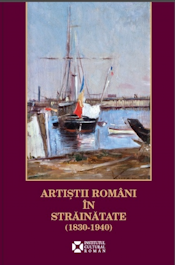
ADRIAN-SILVAN IONESCU, MARIAN ȚUȚUI (coordonatori)
PĂDUREA SPÂNZURAȚILOR, OGLINDĂ A MARELUI RĂZBOI, București: Oscar Print, 2017, 275 p.
ISBN: 978-973-668-443-2
Language(s): Romanian
This volume gathers the papers presented at the conference The Forest Of The Hanged, a mirror of the Great War: 50 years since the release of Liviu Ciulei’s movie, held in Bucharest 26-27 October, 2015, and hosted by the Library of the Romanian Academy. The Conference was organized by G. Oprescu Institute of Art History in partnership with The Romanian Filmmakers Association and The National Film Archive.
ALIN CIUPALĂ
BĂTĂLIA LOR. FEMEILE DIN ROMÂNIA ÎN PRIMUL RĂZBOI MONDIAL, Iași: Polirom, 2017, 392 p.
ISBN: 978-973-46-6577-8
Language(s): Romanian
The book presents Romania's engagement in the first world conflagration from the perspective of the role played by women in supporting the war effort. Historian Alin Ciupală provides solid information regarding the work of several female personalities of the time, such as Olga Sturdza, Sabina Cantacuzino, Nadeja Ştirbei or Martha Bibescu – involved in the organization of campaign hospitals and sanitary trains, the setting up of kindergartens, orphanages, canteens, or finding solutions to ease the life of injured soldiers in hospitals and Romanian prisoners in foreign camps. A special place is reserved for Queen Maria, who, since Romania's neutrality period, has begun to prepare a basis for supporting the war effort from a logistic point of view, being one of the most active supporters (through public actions or within the royal family ) of the country's alliance with the Entente. The author also presents aspects of the social life of women during that period, showing how their work during the First World War determined the change of their social status.
DANA JENEI
GOTICUL ÎN TRANSILVANIA. PICTURA, Foreword by acad. Răzvan Theodorescu, București: Oscar Print, 2016, 240 p., 153 ill.
Language(s): Romanian, with summaries in English (Gothic in Transylvania. The Painting), French (La Gothique en Transylvanie. La Peinture) and German (Gotik in Siebenbürgen. Die Malerei).
ISBN: 978-973-668-456-9.
Excerpts from the book
CONTENTS: • Instead of Introduction • The Stage of Research • Transylvania in the Late Middle Ages • Transylvania between East and West. Historical sketch • The Crisis of the Security Symbols • The New Religious Sensitivity • The Care for Afterlife • Transylvanian Gothic Painting in European Context • The Iconography of Transylvanian Gothic Painting • Thematical Sketch: The Chapel, The Church, The Altarpiece • Images from the World "Beyond" • Devotional Images. The Cult of Saints • Norm and Creativity in Transylvanian Medieval Art • Image. Text. Sources • Artists. Artistic Centers • Patrons • Instead of Conclusion • General Bibliography • Index • Summary • Resumée • Zusamenfassung
„The precise and evocative stylistic analyses, the natural interdisciplinarity – from the history of mentalities to subtleties of the Catholic dogma – make from this book signed by Dana Jenei a work that worthily continues Victor Roth, Virgil Vătăşianu, Vasile Drăguţ, this last one professor being remembered by the pupil, with pious reverence [...]. Excellently equipped in the iconographic and liturgical realms, the author knows to make us close the eschatological and devotional atmosphere, that of the pilgrimages with indulgences from the age preceding the Protestant triumph, in this rather conservative province, that prolonged the Occident, where the burning of Luther’s books was ordered – shortly before the Universitas Saxonum has converted to the new confession – but where the Catholic artifacts survived for long.
Dana Jenei’s volume is a contribution of scholarly attitude and the testimony of an emotional dedication to a subject that she deeply masters”.
Răzvan Theodorescu
MANUELA CERNAT
JEAN NEGULESCU: UN ROMÂN LA HOLLYWOOD, București: Noi Media Print, 2016, 179 p.
ISBN: 9786065720909
Language(s): Romanian
Jean Negulescu directed all the great stars of his time: Bette Davis, Marilyn Monroe, Sophia Loren, Maureen O'Hara, Lauren Bacall, Joan Crawford, Hedy Lamarr, Micheline Presle, Joan Fontaine, Sylva Koscina, Ann-Margret, Leslie Caron. He was known for the ability to guide actresses, leading them to outstanding creations, but he worked with equal authority and efficiency with great actors: Richard Burton, Maurice Chevalier, Peter Lorre, Victor Francen, Fred Astaire, Sessue Hayakawa, Louis Jourdan, Curd Jürgens, Alec Guinness, Rossano Brazzi, Gabriele Ferzetti. His screenwriters were Faulkner, Hemingway, Clifford Odets, Romain Gary, Françoise Sagan. A refined art collector, he generously contributed to the launching of many young visual artists. Precious for our Pantheon, artist with double vocation, painter and filmmaker, and triple cultural identity – Romanian, French and American – Negulescu has not entered yet into the cultural consciousness of the Romanians. When so few Romanian personalities succeeded in achieving a great international notoriety in the western culture of the twentieth century, the indifference with which our compatriots keep treating Jean Negulescu remains, in the best case, incomprehensible. His films were nominated for 31 Academy Awards and they won 4 statuettes. Rated among the top ten Hollywood film directors in the 1950s, the artist remains almost unknown in his homeland.
Manuela Cernat
OLIVIA NIŢIŞ (editor)
ISTORII MonuMentale/ MonuMental HISTORIES, Bucureşti: Arcub & Vellant, 2016;
ISBN: 978-606-8642-90-1
The catalogue of the international exhibition MonuMental Histories (March 17 - May 8, 2016,
Bucharest, Gabroveni ARCUB).
Language(s): Romanian-English bilingual edition
MonuMental Histories seeks to question the relevance of monuments in the process of writing history and memory preservation and to point out the consequences of ideological transitions over monuments, most of them abandoned, not assumed or replaced and reconverted, and others recovered by beautification policies. Igor Grubić is part of the group exhibition.
MonuMental Histories is a multimedia project which brings together video productions by artists and women artists whose discourses integrate political commentary to the mechanisms of historical and social manipulation, ideological handling of visual culture, assumes power critique and normative formulas, the difficult interaction with the ideologically conditioned edifice, but also the potentiality of monumental, architectural utopia as the formula of social non-regimentation and also of forced adaptation to an environment temporarily outside of political interests.
Participating artists: Irina Botea (Ro), Cătălin Burcea (Ro), Igor Grubić (Hr), Elana Katz (De), Sorin Oncu (Ro), Anca Munteanu Rimnic (Ro), Marilena Preda Sânc (Ro), Gabi Stamate (Ro), Valeriu Șchiau (Ro).
Curator: Olivia Nițiș
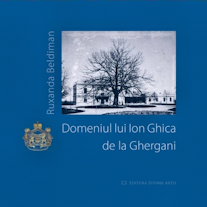
RUXANDA BELDIMAN
DOMENIUL LUI ION GHICA DE LA GHERGANI, graphic design: Cristian Gache, editor: Oana Marinache, with a postscript by Irina Bossy‑Ghica, București: Editura Istoria Artei, 2016, 112 p.
ISBN: 978-606-8839-04-2
The volume brings to light a less known facet of Ion Ghica. A notable politician, diplomat and writer, he was also architect commissioner and art collector.
The author presents the three components of the Ghica's domain in Ghergani: the mansion, the chapel and the park, as well as his work in collaboration with the architects Dimitrie Berindey and Gheorghe Mandrea between 1876-1887.
VIRGINIA BARBU, CORINA TEACĂ (editors)
MĂRTURIILE TOAMNEI. CORESPONDENȚĂ IONEL JIANU-BARBU BREZIANU, with a foreword by Virginia Barbu, București: Editura UNArte, 2016
Language: Romanian
ISBN: 978-606-720-056-0
This volume gathers in a critical edition the letters of Ionel Jianu sent from Paris to Barbu Brezianu, from 1968 until 1993. The correspondence was found in the Barbu Brezianu Archive of "G. Oprescu" Institute of Art History. The letters are of particular relevance for the field of Romanian art history, for a better understanding of the personality of art historian Ionel Jianu, for the in-depth study of the work of Constantin Brâncuşi, as well as for the French-Romanian cultural relationship in the last decades of the 20th century. They also add new details to the identity of ‟The New Generationˮ of Romanian intellectuals from the interwar period, to which both correspondents belonged.
OZANA ALEXANDRESCU
CATALOGUL MANUSCRISELOR MUZICALE DE TRADIŢIE BIZANTINĂ DIN SECOLUL AL XVIII-LEA. FONDUL GRECESC DIN BIBLIOTECA ACADEMIEI ROMÂNE, Vol. II, Bucureşti: Editura Muzicală, 2015, 211 p.
Language: Romanian
ISBN: 978-973-42-0579-0
This book is part of a series started by researchers Ozana Alexandrescu and Daniel Suceava (co-authors of the first volume) in 2010. The aim of the series is to provide an extensive catalogue of the 18th century musical manuscripts of Byzantine tradition, owned by the Library of the Romanian Academy (the Greek Fund).
MARIAN ŢUŢUI (editor)
EROI ŞI ANTIEROI BALCANICI / BALKAN HEROES AND ANTI-HEROES, București: Ed. Fundației Culturale Est-Vest, 2015
Language(s): Romanian-English bilingual edition
ISBN: 973-85680-8-III
Starting with the 2012 edition, the Divan Film Festival (Portul Cultural Cetate, Romania) hosts each year a conference on Balkan cinema. This book gathers the papers presented at the 2014 conference by nine film professors, critics and historians from Great Britain, Greece, Bulgaria, Serbia, Croatia and Romania. After Evadarea din Balcani / Escape from Balkans (2012, issued in 2013) and Comedia balcanică / The Comedy of the Balkans (2013, issued in 2014), the present volume continues to offer fresh insights into the mentalities, customs, human typologies in this part of Europe, such as they were depicted by filmmakers.
IRINA CĂRĂBAŞ, OLIVIA NIŢIŞ (editors)
AFTER BRANCUSI. PROCEEDINGS OF THE INTERNATIONAL CONFERENCE ORGANIZED IN THE FRAME OF THE PROJECT 'THE SAINT OF MONTPARNASSE' FROM DOCUMENT TO MYTH. A CENTURY OF CONSTANTIN BRANCUSI SCHOLARSHIP, with a foreword by Ioana Vlasiu, București: UNARTE, 2014
Graphic design: Ciprian Ciuclea
Language(s): English and French
ISBN: 978-606-720-022-5
This volume gathers the contributions to the international conference After Brancusi, held in October 2013, through the collaboration between Centre for Studies on Brancusi, founded by G. Oprescu Institute of Art History, and the National University of Arts in Bucharest. The call of the conference was extremely open, as was the chosen title. "After Brancusi" designates an indeterminate time when the history of sculpture crossed the problematics of its reception and where Brancusi plays an indicative role, that of a trigger of reflection upon artistic, political and theoretical concepts from various time frames and geographies. The conference has highlighted several lines of interest, seldom or even never before tackled in the Brancusi studies, it has re-contextualized certain interpretations or nuanced and clarified several moments of the sculptor's career.
... the value of this contribution to a mature reappraisal of Brancuși, as well as to the broader, burgeoning study of art and its reception under communist regimes, is illimitable.
Jonathan Vernon, The God that Failed Brâncuși, Art History, Volume 39, Issue 5,
November 2016
OLIVIA NIŢIŞ (editor)
IEEB6. ECOLOGICAL THINKING/ECOLOGICAL PRACTICES, Bucureşti: Experimental Project, 2015; catalogue available online.
Language(s): Romanian-English bilingual edition
ISBN: 978-973-0-17950-7
The catalogue of the 6th edition of the International Experimental Engraving Biennial edited by Experimental Project (Olivia Nițiș and Ciprian Ciuclea) includes the 5 events of the edition focused on "Ecological Thinking and Practices". Photographs from the exhibitions are accompanied by texts signed by the curators to which we add the concepts of each selected work. Texts by: Javier Martin-Jimenez, Adriana Oprea, Olivia Nițiș.
The 6th edition of IEEB (13th December 2014 - 28th March 2015) has addressed issues of ecology. Ecological Thinking and Practices was the general theme of the edition that brought forth a variety of environmental subjects. Artists's thinking and production function as a tool for observing, criticising and revealing aspects of our life that are sometimes slightly debated, going unnoticed, being subject to ignorance or power relations, therefore left marginal. Thinking ecologically represents an imperative for our civilisation today, the parallel process between thinking and acting accordingly providing the context for further political and ethical debates.
BURÇAK EVREN - MARIAN ȚUȚUI SÖYLEŞISI, colection Sinemada Tarih Yazımı, Istanbul, 2015, 83 p.
Language(s): Romanian-English bilingual edition
ISBN: no
This book is a transcript of the conference given by Prof. Burçak Evren and Dr. Marian Ţuțui on 15 November 2014 in the frame of Bosphorus International Film Festival, 1st edition. The dialogue focused on the centenary of Turkish cinema and its pioneers: Sigmund Weinberg and the Manakia brothers.
ADRIAN-SILVAN IONESCU
THE GREAT WAR. PHOTOGRAPHY FROM THE ROMANIAN FRONT, 1916-1919, București: Institutul Cultural Român, 2014.
ISBN: 978-973-577-655-8
Including a great number of pictures, this work is dedicated to the photographers – both professionals and amateurs – who left us a visual diary of life on the front. The album was published in three editions: in Romanian (Războiul cel Mare. Fotografia pe frontul românesc, 1916-1919, ISBN: 978-973-577-653-4), in French (La Grande Guerre : La photographie sur le front roumain, 1916-1919, ISBN: 978-973-577-654-1), and in English.
These photographers and cameramen – champions of expressive imagery, of the impeccably framed photograph taken under enemy fire and of exciting and sometimes even humorous subject matter – have no name and no face, even less so than their subjects, the rank and file soldier, the machine gunner, the pontonier, the aviator, the sailor and the rifleman on the front line, leaning against the parapet of the trenches and looking vigilantly towards the enemy. At most we glimpse the corner of a tunic or coat leaning over the camera on its tripod. (...) Like their collective work, they too are anonymous. They put their lives at risk, just like the ordinary soldiers whose images they immortalised, in order to produce an enduring body of work of great documentary and historical value. In their own ways, the photographer and his subject both contributed equally to the creation of Greater Romania.
Adrian-Silvan Ionescu
CONSTANTIN I. CIOBANU
MUZEUL NAȚIONAL DE ARTĂ AL MOLDOVEI. COLECŢIA PICTURĂ NAŢIONALĂ/ NATIONAL ART MUSEUM OF MOLDOVA. NATIONAL PAINTING COLLECTION, Muzeul Naţional de Artă al Moldovei, Chişinău, 2014, 200 pages + colour reproductions of 165 paintings
Language(s): Romanian-English bilingual edition
ISBN: 978-9975-80-855-2
Focusing on an apparently anachronistic genre – the easel painting – the album presents over 160 artworks, carefully chosen from the collections of the National Art Museum of Moldova. In the era of virtual web museums, this luxury edition album is a traditional tribute to the work of artists, but also of conservators and restorers.
ATRIMONIUL CULTURAL AL REPUBLICII MOLDOVA, authors: Tudor Stavilă (Institute of Cultural Heritage, Chișinău) and Constantin I. Ciobanu (G. Oprescu Institute of Art History, Bucharest), 2nd edition revised and expanded
Language(s): Romanian-English bilingual edition, with an abstract in French
Chișinău: Editura Arc, 2014
ISBN: 978-9975-61-824-3
The album includes various documents and photographs regarding the cultural heritage created across the millennia in the area between the rivers Nistru and Prut. The core of the album is a study on the evolution of arts and crafts in the Republic of Moldova. The illustration presents samples of archaeological vestiges of ceramic and bronze (statuettes, helmets, vessels, etc.), handicrafts (items worked in stone and wood, carpets, folk costumes and others), icons and religious ornaments, sacred and civil architecture, as well as works of modern and contemporary fine arts.
The book was awarded the Stefan Ciobanu Prize of the Moldavian Ministry of Culture.
150 DE ANI DE ÎNVĂȚĂMÂNT ARTISTIC NAȚIONAL, editor: Adrian-Silvan Ionescu
Language(s): Romanian
București: Editura UNArte, 2014
This volume gathers the papers presented at the conference held to celebrate 150 years since the founding of the School of Fine Arts in Bucharest. The contributors shed light on various aspects of the history of the School: the development of high education in fine arts over time, the influence exerted by renowned professors such as Theodor Aman, Cecilia Cuțescu-Storck, Camil Ressu, Simion Iuca, George Sterian, etc. The reader can also find here an account regarding similar institutions in Moldova and Transylvania.
SMALL CINEMAS IN GLOBAL MARKETS: GENRES, IDENTITIES, NARRATIVES (editors: Lenuta Giukin; Janina Falkowska, David Desser)
Language(s): English
Lexington Books, Maryland, USA, December 2014
ISBN: 978-0739196526
The papers included in this volume focus on debates and changes in small cinema industries, analyzing the impact of expansion and diversification of the cinematic product at local, regional, and global levels. Authors address aspects such as identity, revisiting the past, internationalized genres, new forms of experimental cinema, markets and production. Much needed to continue and expand the existing scholarship in the field, the volume is based on research by authors who approach their subject from Western theoretical perspectives with a professional (mostly native) knowledge of the language, cultural realities, and film industry practices. It covers aspects from fifteen different countries, including Bolivia, Brazil, China (Hong Kong), Croatia, East Africa (Kenya, Tanzania, and Uganda), Greece,Indonesia, Lithuania, Bulgaria, Poland, Romania, Morocco, and the United States. Among the 14 contributors is film researcher Marian Țuțui (G. Oprescu Institute of Art History), author of the study New Bulgarian Documentary.
SZATHMÁRI. PIONIER AL FOTOGRAFIEI SI CONTEMPORANII SĂI / PIONEERING PHOTOGRAPHER AND HIS CONTEMPORARIES
Editor: Adrian-Silvan Ionescu
București: Oscar Print, 2014
ISBN: 978-973-668-377-0
Accompanied by a DVD, this volume gathers the papers presented at the international conference held to celebrate the 200th anniversary of the birth of Carol Popp de Szathmari. The contributors offer fresh insight into the life and career of this gifted artist, who has gained fame both as a photographer and as a painter. Richly illustrated, the publication includes a number of previously unpublished pictures.
OLIVIA NIȚIȘ
ISTORII MARGINALE ALE ARTEI FEMINISTE
Language: Romanian
Design: Ciprian Ciuclea
București: Editura Vellant, 2014
ISBN: 978-973-1984-79-7
Istorii marginale ale artei feministe [Marginal Histories of Feminist Art] is the first book published in Romania dedicated to feminist theories and practices in contemporary art in Eastern Europe. The author follows the sociopolitical and cultural contexts in this area as well as the ideological mechanisms that shaped specific discourses differently intersected with the paradigm of gender and feminist issues before and after 1990. Marginality is seen both as reality to be assumed, and as the effect of micro-histories oriented towards overcoming dichotomous type mannerisms such as East / West, marginal / peripheral.
COLECȚII DE ARTĂ – Vol. V of the series TEZAURUL ACADEMIEI ROMÂNE
Series edited by acad. Ionel Haiduc and acad. Păun Ion Otiman
Volume edited by Marina Sabados
Photographs: Maria Ştefănescu
Language: Romanian
București: Editura Academiei Române, 2014
ISBN: 978-973-27-2406-4
Less known by the public, the rich art collection of the Romanian Academy is catalogued in this book by researchers of G. Oprescu Institute (Ioana Vlasiu, Corina Teacă, Ruxanda Beldiman, Olivia Nițiş, Virginia Barbu, Marina Sabados) and by museum specialists (Ana Bârcă, Olivia Tudoran Ciungan, Mircea Dunca, Mircea Hortopan). The book invites the reader to learn more about the remarkable artworks and decorative objects donated over time to the Romanian Academy by personalities such as George Oprescu, Victor Eftimiu, George Călinescu, Dumitru Furnică Minovici and others.
SIMPOZIONUL INTERNAȚIONAL DE MUZICOLOGIE BIZANTINĂ. 300 DE ANI DE ROMÂNIRE (1713–2013), editors: Nicolae Gheorghiță, Costin Moisil, Daniel Suceava
Bucureşti: Editura Glissando, December 2013
ISSN: 2344-6188.
This volume gathers the 26 papers presented at the International Symposium of Byzantine Musicology, 2nd ed., by researchers from Greece, Finland, Macedonia, and Romania. The event was organized by the National University of Music together with G. Oprescu Institute of Art History.
KAREL ZDENĚK LÍMAN. ARHITECTUL CEH AL CASEI REGALE A ROMÂNIEI / THE CZECH ARCHITECT TO THE ROMANIAN ROYAL COURT, București: Igloo, 2013
Language(s): Romanian-English bilingual edition
ISBN: 978-606-8026-28-2
Richly illustrated, the publication sheds light on the various architectural projects carried out by Líman during his stay of more than 30 years in Romania. Authors: Ruxanda Beldiman (researcher at G. Oprescu Institute, Department for Modern Art and Architecture), Mircea Hortopan, Narcis Dorin Ion, Sorin Vasilescu.
NINETEENTH-CENTURY PHOTOGRAPHS AND ARCHITECTURE. DOCUMENTING HISTORY, CHARTING PROGRESS, AND EXPLORING THE WORLD, editor: Micheline Nilsen
Ashgate Publishing Group, Farnham, Surrey, England – Burlington, USA, 2013
Language(s): English
ISBN: 978-1-4094-4833-4
Eschewing the limiting idea that nineteenth-century architecture photography merely reflects functionality, the objective of this collection is to reflect the aesthetic, intellectual, and cultural concerns of the time. The essays hold appeal for social and cultural historians, as well as those with an interest in the fields of art history, urban geography, history of travel. Contributors include Adrian-Silvan Ionescu (G. Oprescu Institute of Art History), author of the study Romanian Architecture and Cityscape: The Legacy of Nineteenth-Century Photography.
ISTORIA ROMÂNILOR, VOL. X: ROMÂNIA ÎN ANII 1948-1989, editor: acad. Dinu C. Giurescu
Bucureşti: Editura Enciclopedică, 2013
Language(s): Romanian
ISBN: 973-45-0667-5.
The 10th volume of the monumental history of Romanians, published by the Romanian Academy, gives a broad overview of the political, social, economic and cultural changes brought by the communist regime.
Chapters on art history were written by current and former researchers of G. Oprescu Institute: Carmen Popa (music, pp. 1093-1103), Daniela Gheorghe and Ion Cazaban (theatre, pp. 1103-1112), Manuela Cernat (film, pp. 1113-1133), Ioana Vlasiu (fine arts, pp. 1133-1140), Ruxanda Beldiman (architecture, pp. 1142-1148).
MARINA SABADOS
GRIGORESCU LA AGAPIA
Language(s): Romanian
Iaşi: Editura Doxologia, 2012, 240 p., 207 ill. + 37 plates
ISBN: 978-606-8278-29-2
Nicolae Grigorescu, a founder of Romanian modern art, began his career as a church painter. The author analyses in her book the mural paintings and icons created by young Grigorescu at Agapia Monastery between 1858 and 1861. The work fills a gap in the field of Romanian art history, since the religious painting of the 19th century – whose secular tradition was coming to an end – is less explored.
DICŢIONARUL SCULPTORILOR DIN ROMÂNIA. SECOLELE XIX-XX, Vol. I-II, edited by Ioana Vlasiu
Authors: Ioana Vlasiu, Gabriel Badea-Păun, Virginia Barbu, Ruxanda Beldiman, Irina Cărăbaş, Olivia Nițiş, Adrian-Silvan Ionescu, Tudor Stavilă, Corina Teacă, Adriana Şotropa, Alexandra Titu, Gheorghe Vida
Language(s): Romanian
Bucureşti: Editura Academiei Române, 2011-2012.
ISBN vol. I: 978-973-27-2126-1
ISBN vol. II: 978-973-27-2222-0.
The dictionary of Romanian sculptors – result of a laborious research – is a valuable tool for art historians. Both volumes are available online:
RUXANDA BELDIMAN
CASTELUL PELEŞ, EXPRESIE A FENOMENULUI ISTORIST DE INFLUENŢĂ GERMANĂ
Bucureşti: Editura Simetria, 2011, 304 p.
Language(s): Romanian
ISBN: 978-973-1872-22-3
This monograph album is adapted from the author's PhD. dissertation. Through many documents hitherto unpublished and a comprehensive iconographic material, the book covers various aspects regarding Peles Castle: the stages of its construction, the stylistic particularities of the building, and also the relationship between commissioners and architects.
SILVAN. PORTRETISTUL / THE PORTRAIT ARTIST
Introduction, chronology and illustration selection: Adrian-Silvan Ionescu
Language(s): Romanian-English bilingual edition
Bucureşti: Institutul Cultural Român, 2011, 190 p.
ISBN: 978-973-577-627-5
The album comprises numerous works signed by Silvan, the artist who has created in his career of more than seven decades a rich gallery of caricature portraits featuring celebrities from the world of letters, theatre, music and fine art. Along with portraits of writers and artists who are familiar especially to the Romanian audience, the collection includes worldwide known personalities, such as Eugène Ionesco, Constantin Brancusi, George Enescu, Sir John Barbirolli, Dinu Lipatti, Herbert von Karajan, Yehudi Menuhin, Arthur Rubinstein, Dmitri Shostakovich, Igor Stravinsky, Pablo Picasso, Luciano Pavarotti.
VLAD BEDROS
ARMENIAN ARTISTIC HERITAGE IN ROMANIA. BETWEEN EXILIC NOSTALGIA AND CULTURAL INTEGRATION
Language(s): English
București: Noi Media Print, 2011
ISBN: 973-1805-97-9
Armenian communities have been formed in Moldavia, Wallachia and Transylvania centuries ago – and their cultural contribution is significant. As the title shows, this book provides an overview of the Armenian artistic heritage in Romania. The author underlines the fundamental affinity of Armenian diaspora with the majority population.
The English version was published together with the original text (Patrimoniu artistic armenesc în România. Între nostalgia exilului şi integrarea culturală, ISBN: 973-1805-96-2).
OZANA ALEXANDRESCU and DANIEL SUCEAVA
CATALOGUL MANUSCRISELOR MUZICALE DE TRADIŢIE BIZANTINĂ DIN SECOLUL AL XVIII-LEA. FONDUL GRECESC DIN BIBLIOTECA ACADEMIEI ROMÂNE, Vol. I
Language(s): Romanian
Bucureşti: Editura Muzicală, 2010
ISBN: 978-973-42-0580-6
In the first volume of their work, the authors have thoroughly catalogued a part of the 18th century musical manuscripts of Byzantine tradition, owned by the Library of the Romanian Academy (the Greek Fund). The book is a useful resource for scholars specialising in Byzantine music.
|
Be notified of page updates |
|
powered by ChangeDetection |





